Blockchain.com July Market Outlook: The Cryptocurrency Endgame

What is the endgame for cryptocurrency?
More specifically, how should we interpret forecasts like the one made by famed investor Jim Rogers last week that if cryptocurrencies like bitcoin ever become too successful that governments will “eliminate” them.
And what does the growing likelihood of a programmable US digital dollar mean for the competitiveness of bitcoin, stablecoins, and other cryptoassets?
Earlier this year we launched our monthly outlook series and accompanying videocasts, and we’re pleased to offer you our latest thoughts on what’s driving crypto markets and other topics relevant for understanding the rapidly evolving blockchain technology landscape. Here are some of the highlights from our latest outlook:
July Outlook Summary
1.Crypto outperformed stocks and gold in Q2 but underperformed for the month of June
- Crypto continues to outperform other asset classes such as equities on both a quarterly basis and year-to-date
- While Bitcoin (BTC) and Ethereum were down ~5.3% at end of June it was mostly a “flat” month, with bitcoin’s price averaging ~$9,500 for June, in line with its end of May level
- Significant decline witnessed in bitcoin’s price volatility over the past several months; discussion of pros/cons of crypto price volatility
- Profile of several prior periods when bitcoin’s price entered a multi-month “holding pattern”
2. On-chain insights: Highlights from the Blockchain.com data science team
- Nigeria, South Africa, and the Dominican Republic are once again in Top-10 list of countries showing increasing use of Blockchain.com products; Bangladesh flipped from a Top-10 decreasing to increasing country
- Bitcoin ownership concentration continued to widen with 3,078,873 addresses holding at least 0.1 BTC (+1.3% over May), and 819,587 addresses hold 1 BTC (+0.4% over May)
3. The cryptocurrency endgame
- View that cryptocurrency, if it one day becomes massively successful will be banned, continues to be expressed by notable investors
- Trends in regulation, particularly amongst key jurisdictions and regulators, do not support this view
- Highly unlikely a US digital dollar will “copy and paste” all major cryptocurrency features and serve as a full replacement for bitcoin
4. Stablecoins: the new vehicle to flee capital controls
- In the wake of Hong Kong protests, evidence that cryptoassets are being used by Chinese individuals to move and preserve wealth
- ~80% of capital moving offshore from China has poured into USD-pegged stablecoins (primarily Tether) with the remaining ~20% into bitcoin
5. What we’re reading, hearing, watching
1. Crypto outperformed stocks and gold in Q2 but underperformed for the month of June
Overall, crypto outperformed stocks and gold in Q2. In the second quarter Bitcoin (BTC) and Ethereum were up 43.4% and 70.1%, respectively, with gold (+12%) and equities (+26%) also performing well (Table 1).
However, both BTC and ETH were down slightly for June, whereas stocks (particularly tech stocks) were up for the month. Gains in some growth stocks, such as Tesla (TSLA), which is now up ~5x over the last twelve months, contrast dramatically with a nearly flat BTC price over that same period.
Table 1: Price Comparison (% Change): Bitcoin, Ethereum, Gold, US Equities, Long-dated US Treasuries, US Dollar

The relatively greater volatility and price action of some equities is likely having a negative impact on crypto trading interest. For the second month running we saw major cryptocurrencies trading relatively flat and entering what could be characterized as a “don’t just do something, stand there” phase (Figure 1).
Figure 1: Bitcoin’s price has been largely range bound between ~$9,000-$10,000 for the past two months
Bitcoin’s has seen a dramatic decline in volatility in the three months since crypto’s Black Thursday on 12 March of this year. Indeed, bitcoin’s volatility is beginning to approach levels of some major fiat currencies, such as British pound sterling (GBP) (Figure 2).
Figure 2: Bitcoin’s declining volatility trending towards some “emerging market” currencies (eg British £)
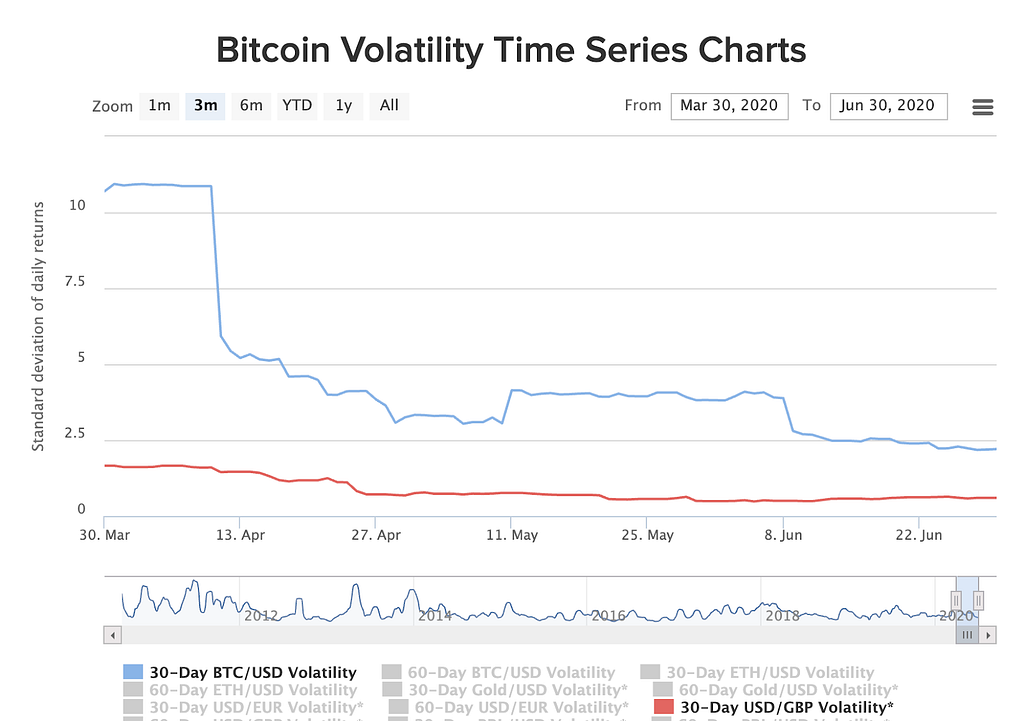
How long will crypto prices remain flat, and which direction will they break?
While nothing in these monthly outlooks should ever be construed as investment advice, we did want to comment on historical periods when bitcoin’s price entered a seemingly similar “holding pattern”. For example, in early 2019 bitcoin’s price hovered around ~$4,000 for approximately four months before breaking upward ao approximately $13,000 (Figure 3).
Figure 3: Past instances when BTC’s price entered a multi-month “holding pattern” (consolidation phase) have often been followed by large upward moves
In 2015–16 we also saw another extended period of relative bitcoin price stability: in 2015 bitcoin’s price was hovering in the ~$250 range for an approximately six-month period, then climbed into the ~$400 range for a number of months (Figure 4). Towards the end of 2016, around the time of the last US presidential election, the price then started more rapidly ascending to ~$1,000, setting up a dramatic ~20x price increase in 2017.
Figure 4: BTC’s record setting upward price move coincided with the last US presidential election
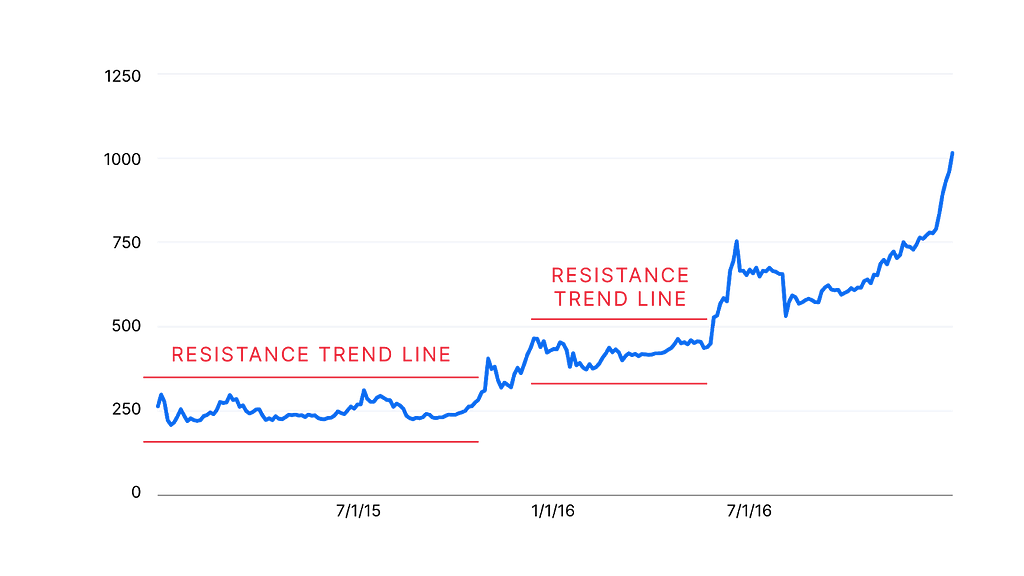
While the above two examples highlighted periods when relative price stability was followed by significant upward price moves, it is important to note that there have also been instances where the reverse occurred. For example, for much of the second half of 2018 bitcoin’s price was trading largely in the $6,000-$7,000 range, until breaking sharply downward towards the end of the year and plummeting close to $3,000 in December 2018.
What would sustained lower volatility mean for crypto in the longer run?
Previously we have highlighted the numerous benefits of outsized cryptoasset price volatility, but it is also worth noting the double-edged nature of price volatility (Figure 4).
Figure 4: Outsized volatility is a double-edged sword for crypotasset adoption
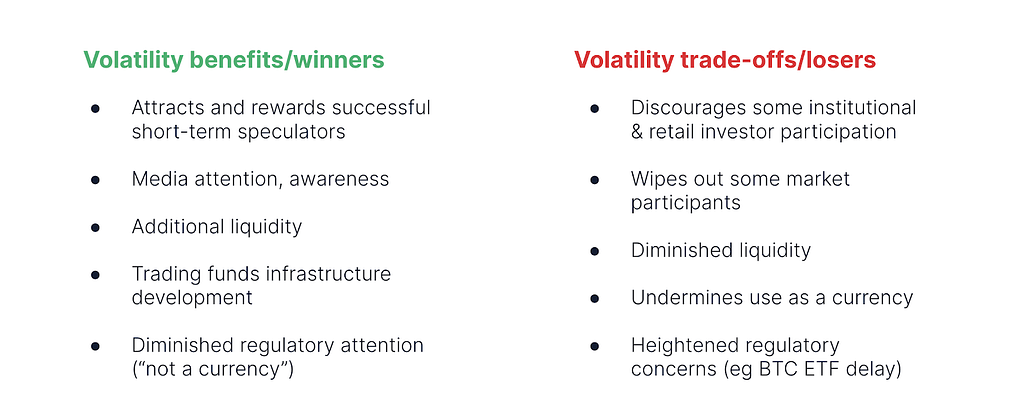
Overall, it is our view that outsized volatility has been net positive for cryptoassets during the first decade+ of bitcoin’s existence, and that continued outsized volatility in the near-term may very well continue and remain a net positive.
However, as cryptoassets continue to mature and grow in terms of technology, size, liquidity, and sophistication (eg options and derivatives markets, greater institutional participation), it would be reasonable to expect volatility to trend down from historical levels over the longer-term. Also, as we discussed last month, lower volatility may also play a constructive role in the future regulation of cryptoassets as financial stability and systemic risk regulators consider how to respond to significant increases in cryptoasset usage and market size. In short, if change occurs too swiftly this could prompt a sudden regulatory backlash, whereas steadier changes may reduce the likelihood of a regulatory crackdown.
In sum, relatively lower volatility going forward is not necessarily something to view unfavorably, but may actually play a constructive role in increasing cryptoasset adoption.
2. On-Chain Analysis
Each month we dive into on-chain data to explore interesting trends or movements on the Bitcoin network.
We start at a high level with a look at network activity in June compared to May. Overall, after observing significant increases in network activity in May we saw June figures stabilize, with a slightly decreased market capitalization, slightly more transactions, and a lower number of active addresses (Table 2).
Table 2: Bitcoin network activity — June vs May

When we look at average network fees we can see there was significantly less network congestion and a resultant lower average fee per transaction in June, with the average fee per transaction at $1.28 as compared to $3.36 in May.
Trending countries⁴
Another question we’re often curious about is how crypto usage is trending at the country level. In June we saw a number of countries increase their fraction of total Blockchain wallet transactions, most notably Vietnam, Bangladesh, and the South Africa (Table 3)
Table 3: Trending countries: increase in use in June over May

Continuing from May, Nigeria, South Africa, and Dominican Republic were once again in the Top-10 increasing country list. Bangladesh flipped from the Top-10 decreasing to increasing use, and the US dropped out of the top-10 increasing list.
Meanwhile, the fraction of transactions sent from China, Latvia and Belarus have decreased by 39.2%, 19.7% and 16.6% in comparison to April. China saw the largest decline in use in June and was the only country that remained from May in the list of top-10 decreasing use countries.
Table 4: Trending countries — decrease in use in June over May

Bitcoin ownership concentration
Bitcoin ownership distribution, as measured by the number of unique addresses owning a material quantity of bitcoin, continued to expand. The number of addresses holding at least 0.1 BTC was up +1.3% over May, and addresses holding at least 1 BTC increased +0.4% over May⁵:
- 3,078,873 addresses (10.1% of total addresses) have more than 0.1 BTC, and represent 98.9% of total bitcoins
- 819,587 addresses (2.7% of total addresses) have more than 1 BTC, and represent 95.0% of total bitcoins
3. The cryptocurrency endgame
Recently legendary investor and author Jim Rogers said that if cryptocurrencies like bitcoin ever become too successful that governments will “eliminate” them.
As remarkable as the rise of bitcoin and crypto has been in just a little over a decade — from zero to tens of millions of users and hundreds of billions in value — is Rogers correct that crypto is ultimately doomed? Will bitcoin become a victim of its own success, or be out-competed by central bank digital currencies?

A number of investors share Rogers’ skepticism around continued regulatory tolerance towards crypto, and this view has served as a justification for some to sit on the cryptocurrency sidelines. After all, what is the point of studying and investing in a new technology and asset if you believe any future success will either be capped or ultimately crushed by the long arm of the law?
However, as time passes there are more and more reasons to be skeptical of the view that governments will one day coordinate en masse and attempt to eliminate cryptocurrencies if they grow past some large, undefined size.
First, today’s “disunited nations”, and the decline in global cooperation that characterizes our present world, make it unlikely that hundreds of countries will simultaneously arrive at a unanimous regulatory view on cryptocurrency. There is also the difficulty of implementing globally any such crackdown given the decentralized nature of cryptocurrency.
But a perhaps equally important reason to be skeptical of Rogers’ view is the existing evidence of how cryptocurrency technology is already being regulated in key jurisdictions, particularly the United States, which continues to maintain outsized global influence over financial and technology regulation.
The dawn of significant cryptocurrency regulation, which many date to the 2013 US FinCEN guidance, set the tone for much of what has followed: regulators have generally attempted to strike a balance between fostering innovation while attempting to line up cryptocurrencies with various regulatory frameworks. The evidence of this more balanced approach by US authorities has continued to be seen across a number of key regulatory and legal developments, including:
- 2017 authorization by US CFTC of Chicago bitcoin futures markets
- 2018 NY DFS approval of new stablecoins
- 2018 SEC communication on the principle of decentralization in evaluating the applicability of securities law to blockchain networks (“sufficiently decentralized”)
While some smaller countries such as Switzerland have gone even further in creating an attractive regulatory environment for cryptocurrency, the US is no means the only large country to create space for cryptocurrency use and growth:
- In 2020 an Indian Supreme Court ruling lifting ban on Indian banks conducting business with cryptocurrency firms
- Ongoing tolerance in China of cryptocurrency trading and mining despite numerous announcements of regulatory crackdowns
Overall, most lawmakers and regulators around the world have not sought outright bans of cryptocurrency. This is at least partly due to the growing recognition of the innovative potential of cryptocurrency to help modernize our antiquated and inefficient financial system.
This brings us to the topic of a programmable US digital dollar, viewed by some as a potential existential competitive threat to cryptocurrency.
As we described recently on our blog, the topic of introducing a US digital dollar has become a high priority for several reasons, including the many inadequacies in our monetary and financial system painfully revealed by the ongoing COVID-19 pandemic. Billions of stimulus dollars already appear to have been wasted due to various errors and inefficiencies, while a significant number of people have not been able to obtain the financial assistance they have been offered and so desperately need.

With a US digital dollar now appearing inevitable and possibly imminent, is there a chance that central bank digital currencies will obviate the need for cryptocurrencies like bitcoin?
While there is much still left to determine about the ultimate nature and feature set of a widely used digital dollar, our view is that it is highly unlikely a US digital dollar will “copy and paste” all major cryptocurrency features, or serve as anything remotely resembling a replacement for bitcoin.
Indeed, looking at a list of features often cited for bitcoin’s success and growth it is not clear a US digital dollar would seek to fully imitate even a majority of bitcoin’s key characteristics:
- predictable coin supply schedule and capped total supply (21 million total coins), making it a scarce investment asset
- relatively decentralized architecture, trust minimization, and status as a bearer instrument (seizureship resistance)
- technical resiliency (uptime)
- censorship resistance and privacy
- programmability
- efficient, relatively low cost, and otherwise useful for certain types of payments
- price appreciation (“number go up”)
Even incorporating the bearer nature of US dollar banknotes/coins into a US digital dollar is by no means a settled question, as some leading digital dollar proposals call for a highly centralized digital dollar system based on the Federal Reserve’s existing centrally controlled account system.
Cryptocurrency characteristics much more likely to be included in a US digital dollar are technical resiliency, payments efficiency, and programmability. But a US digital dollar that only overlaps across these handful of dimensions would not destroy the entire value proposition of relatively more decentralized cryptocurrencies like bitcoin.
Further, there is even the possibility that blockchain networks like Ethereum may underpin a US digital dollar, much as blockchain networks today serve as the rails for many USD-pegged stablecoins. Other leading US digital dollar proposals call for a broad public-private partnership, where private sector corporations and platforms lead on technology development and deployment and play a critical role in the functioning of a US digital dollar. Such a partnership model would be attractive to many central banks, like the Federal Reserve, that are hesitant to convert into full service banks and offer accounts and services to millions of citizens.
Finally, it is also worth noting how rising US-China tensions factor not just in accelerating the rollout of a US digital dollar, but in how open blockchain networks like Bitcoin and Ethereum will increasingly come to be viewed from a geopolitical perspective. Nations such as the US that support the right of open expression and free movement of capital are in greater alignment with the censorship resistant nature of public blockchain networks than countries with more restrictions on speech and financial flows, such as China. In other words, the existence and growth of public blockchain networks have the potential to augment US values across an increasingly tense international stage and may find political support for these reasons as well.
4. Stablecoins: The new vehicle to flee capital controls.
Guest feature by Eliezer Ndinga from Amun

Today, June 9th, 2020, marks the first year since the beginning of Hong Kong protests where around a million people initially marched against Beijing’s extradition law to Mainland China. Over the past year, the protests rapidly intensified and fueled widespread unrest the month following the start of the demonstrations — especially due to police inaction the night a mob attacked a group of pro-democracy protestors.
The Amun research team has investigated how this unprecedented movement has gradually led to behavior changes regarding the use of cryptoassets, chiefly USD-pegged stablecoins, as a major investment vehicle for promptly fleeing capital controls in an attempt to preserve the wealth of Chinese individuals.
China Money Flowing to Singapore and Stablecoins
Over the past decades, the Asia Pacific region has accounted for almost 40% of the global billionaire population, with China being among the hottest wealth-generating hubs in the world — creating two new billionaires every week. Family offices have increasingly become popular vehicles to manage the wealth of high-net worth families in China or as a means to set up offshore accounts.. But in the midst of capital controls and anti-corruption campaigns, there has been an increasing desire from less-wealthy Chinese families and individuals to move their capital out of China.
The emergence of a China-centred blockchain system, which would undoubtedly make it easier for the Chinese government to oversee and track the financial activity of its citizens, will not meet the rising need for financial freedom among some within China. The recent demonstrations have significantly triggered money flows to primarily Singapore — due to advantages such as long standing rapid air connections with China prior to the COVID-19 pandemic.
Although as an inherently digital, censorship-resistant, and neutral asset, Bitcoin has not been the first cryptoasset of choice to flee renminbi-denominated assets due to market volatility. USD-pegged stablecoins have ended up being just as attractive assets for those seeking to avoid losing large portions of their wealth due to price fluctuations over the short and medium terms. As a matter of fact, QCP Capital a Singapore-based cryptoasset trading firm, has witnessed Hong-Kong-based investors fleeing to Singapore and trading stablecoins, predominantly Tether, in an attempt to preserve their wealth.
According to QCP, 80% of capital has poured into stablecoins while the remaining 20% has gone into Bitcoin. This information is unfortunately not publicly available as much of crypto adoption in Asia happens underground especially following the crackdown on crypto exchanges by the Chinese government starting in 2017. For example, in Hong Kong, QCP Capital reported that investors trade Tether physically. This method is mainstream so that they are able to move money away cheaply and quickly compared to setting up an offshore account which might take almost a month due to stringent know-your-customer and anti-money laundering procedures. To mitigate counterparty risk, due to ongoing issues with identity fraud, QCP Capital follows KYC procedures and asks for collateral denominated in stablecoins.
The rising demand for encrypted messaging apps for public gatherings
In an effort to evade public gathering restrictions, as pro-democracy rallies raged in the territory, Hong Kong-based protesters have started to coordinate their actions using encryption-enabled messaging applications such as Telegram. In a similar manner, to meet and initiate trades QCP users communicate via a Telegram group, and many other similar groups owned by OTC desks or ran by regular investors, following a similar trend of building out their community via word-of-mouth growth.
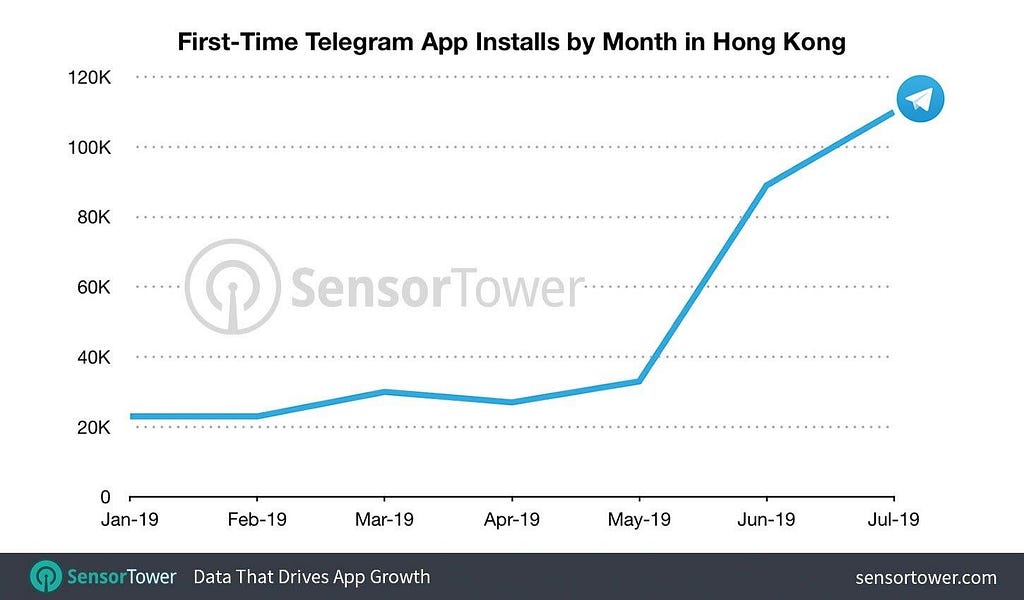
The behavior changes we’ve seen due to these demonstrations are here to stay in the foreseeable future especially as crypto exchanges and other liquidity providers prevent China-based investors from opening accounts due to specific clauses in their terms and conditions — a phenomenon the 21Shares research team discovered in this study.
It is safe to say that stablecoins are becoming a pain-killer product for many investors in such situations. This capital outflow from renminbi-denominated assets to USD-pegged stablecoins will strengthen the US dollar hegemony as the world’s reserve currency. Nonetheless, with interest-bearing accounts like the one launched by Blockchain.com, there could eventually be capital flowing from stablecoins to Bitcoin by Chinese institutional investors and high-net-worth individuals, especially among tech-savvy cohorts
5. What we’re reading, hearing, watching
Crypto
- The Daily Gwei: A Lesson in Pumpamentals
- Unchained Podcast:
- Why the US Needs to Have a Digital Dollar
- Why Bitcoin Now: Mike Novogratz and Raoul Pal on ‘the Single Greatest Brand’ of the Last 10 Years
- CoinDesk:
- National Science Foundation Funds Research Into Crypto Dollars
- Central Bank Digital Currencies Need Decentralization (Editor’s note: while we appreciate the overall thrust of this Op-Ed we do not agree with all aspects of it, such as Exhibit 4, which labels cryptocurrency as “negative” across dimensions such as “consumer well being”, “ethics”, etc.)
Beyond crypto
- The COVID Shock to the Dollar
- An Open Letter to Randal K. Quarles, Federal Reserve Vice Chair for Supervision (critique of Fed’s decision to limit disclosure of this year’s large-bank stress tests)
- Waze for Viruses
- The Age of Magic Money
- Sveriges Riksbank Economic Review: second special issue on the e-krona
Important note
The research provided herein is for your general information and use and is not intended to address your particular requirements.
In particular, the information does not constitute any form of advice or recommendation by Blockchain.com and is not intended to be relied upon by users in making (or refraining from making) any investment decisions.
Appropriate independent advice should be obtained before making any such decision.
Footnotes:
- The number of confirmed transactions in the public blockchain
- The number of confirmed transactions sent from our Blockchain Wallet and API
- Average daily number of unique addresses used as inputs and outputs in the confirmed transactions
- Based on a subset of our wallet users. The top 10 excludes countries with fewer than 0.3% of total number of transactions
- Source : https://bitinfocharts.com/top-100-richest-bitcoin-addresses.html
Blockchain.com July Market Outlook: The Cryptocurrency Endgame was originally published in @blockchain on Medium, where people are continuing the conversation by highlighting and responding to this story.


